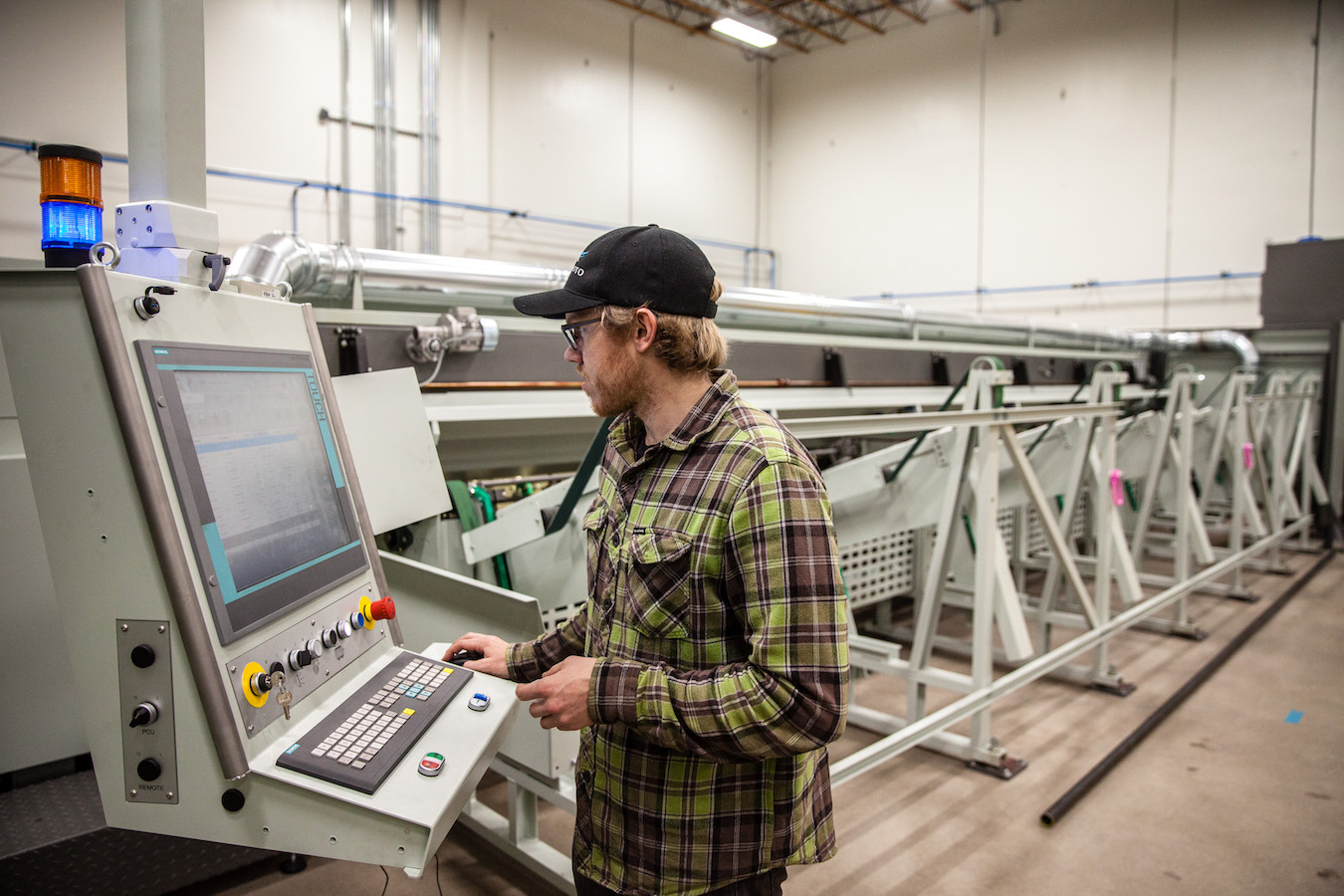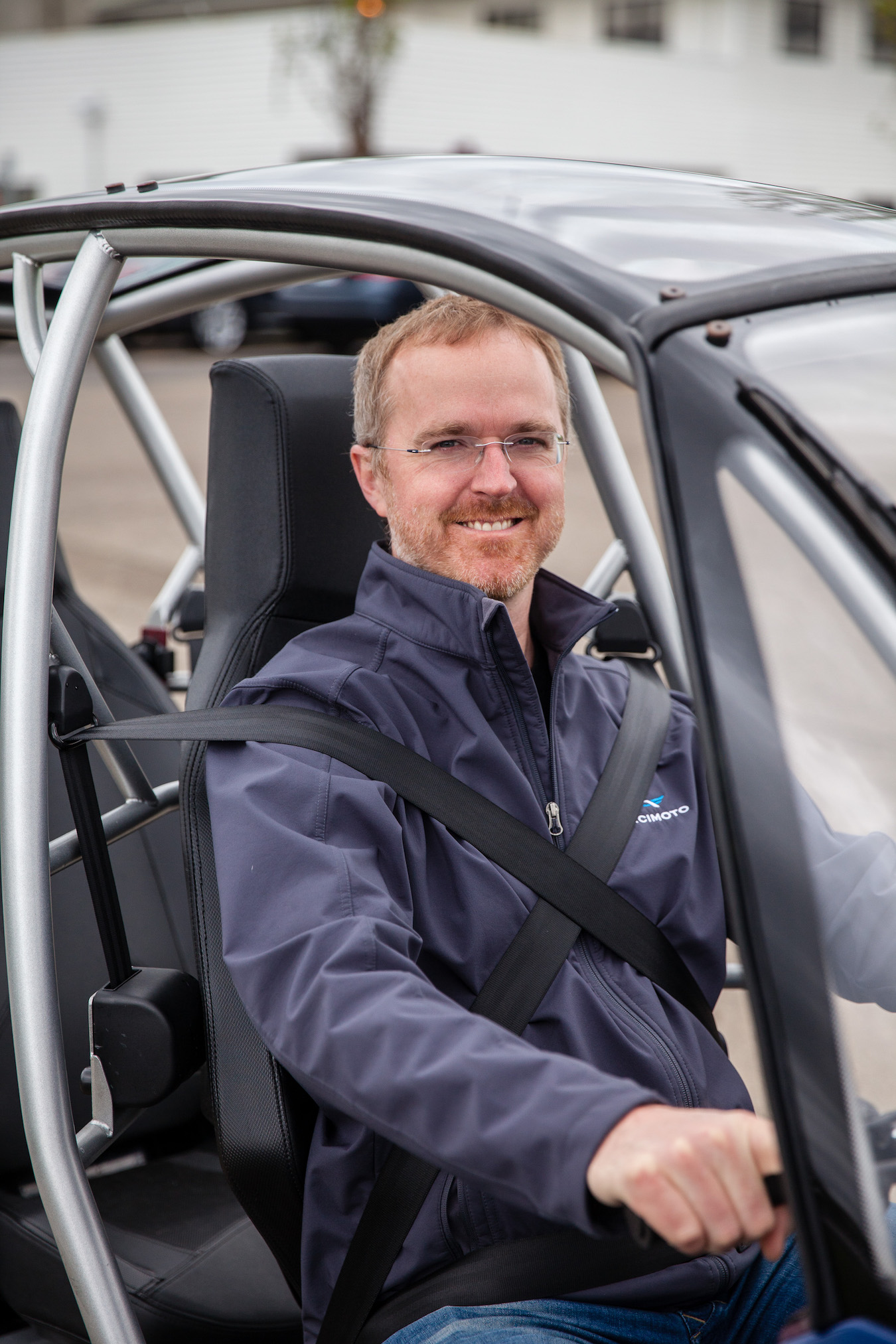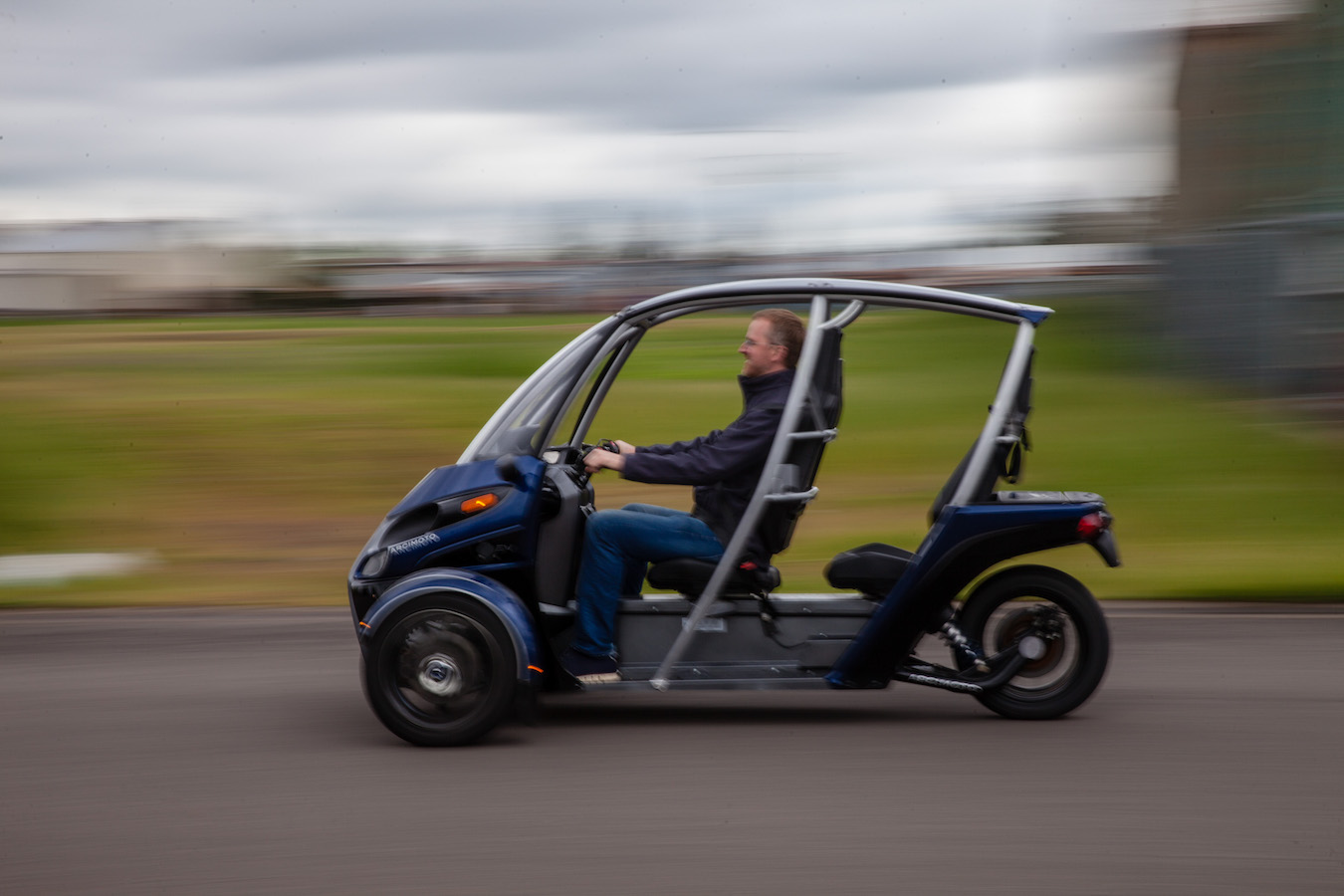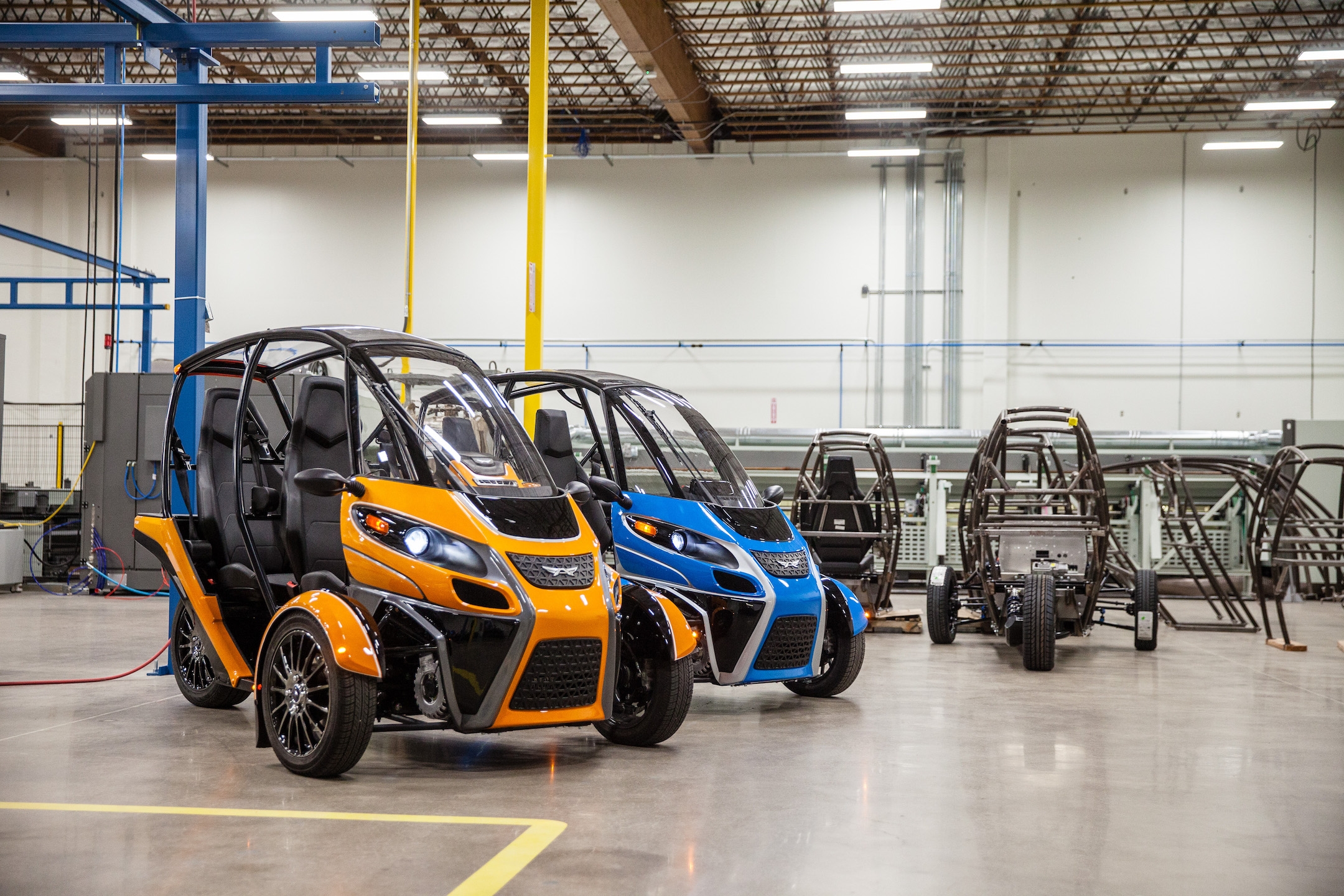Affordable, electric, a blast to drive, and made in Oregon: Electric vehicle company Arcimoto preps to roll out its long-awaited Fun Utility Vehicles.
Wherever you’re sitting right now, odds are good that you’re within sight of a parked car or two. They’re probably big, they probably made a whole lot of noise and burned some fossil fuel on their way in, and they’re definitely taking up lots of space.
Electric vehicle company Arcimoto, Inc. (NASDAQ: FUV) is out to challenge the premise that each of us needs to travel to work, the grocery store and the gym encased within 4,000 hulking pounds of steel. Arcimoto’s proposed alternative? A three-wheeled electric vehicle designed to comfortably carry two people and their things while making the smallest possible environmental impact, and for a lower cost than anything else on the market.
“At least 70 percent of your experience right now is devoted to parking or driving or staring at vehicles,” points out Arcimoto Vice President Jesse Fittipaldi. “You see all that stuff and just assume it’s part of life. But what if we didn’t assume that? What if we had the opportunity to change it?”
A human landscape less dominated by bulky cars, the pollution they create, and the roads they require is not only possible, insists Fittipaldi; at this point, it’s very nearly inevitable.
Arcimoto is delivering that brave future to the masses a little bit faster, and for a lot less money, than other vehicle start-ups and traditional auto manufacturers as the company begins final assembly on the world’s first street-ready, pure electric Fun Utility Vehicle, right out of its shiny new West Eugene manufacturing facility, aptly dubbed “AMP” (Arcimoto Manufacturing Plant).
The growing company’s doubly ambitious mandate: to build insanely efficient, incredibly affordable everyday commuter vehicles right in Oregon, and, while they’re at it, to help consumers reconsider some closely held assumptions about what, where, why and how we drive.

Keeping it Lean
If Arcimoto’s numbers are any clue, EVs might well be poised to storm the automobile market. An enthusiastic affinity group has rallied around the company since its days as a design-and-development studio, but Arcimoto’s IPO hastened its transformation into a global manufacturing venture.
The IPO, completed in six weeks, raked in $20 million (double the target amount), and that is enabling Arcimoto to “leap forward to a more efficient and self-sufficient way of manufacturing,” says Arcimoto Chief Operating Officer Terry Becker. This means installing key pieces of automated production equipment right in-house, establishing processes for higher rates of production and turning the 30,000-square-foot facility into a Lean manufacturing exemplar.
It’s the ideal testing ground for designing a sleek, highly repeatable manufacturing process as Arcimoto perfects, assembles, and delivers its Retail Series to 2,500 pre-order customers, says Arcimoto President and Founder Mark Frohnmayer. “The way [COO] Terry describes it is building a sewing machine of a factory, where there’s no wasted effort, with everything moving like clockwork through it.”
This approach disrupts traditional factory production models at pretty much every step, says Fittipaldi. And that’s good: “We’re proving that we can build a factory capable of producing an on-road vehicle for a significant factor less than what traditional automotive companies have gone to market with.”
But setting up shop in Eugene also just made practical sense, Frohnmayer adds: “The idea that we can’t solve our own transportation problems has always been a little silly to me. The model that makes sense to me isn’t some giant mega-factory in China building for everywhere, but rather, factories all over the place that employ local folks in solving their own transportation problems.”
 Arcimoto President and Founder Mark Frohnmayer.
Arcimoto President and Founder Mark Frohnmayer.
Fulfilling the promise of affordable EVs
The technology’s there. The infrastructure’s getting there. So why isn’t everybody driving an electric vehicle?
The biggest barrier to EV adoption has simply been cost, according to Frohnmayer, but the $12,000 price tag on the FUV primes consumers to finally embrace electric: “The key to Arcimoto is building a vehicle that lands at the price point of a used car; not an expensive new car. The cost of these is more than comparable, and we’re in for a real sea change on the road in terms of the vehicles we see.”
Until now, no ultra-efficient, low-cost commuter vehicle has materialized to make good electric’s looming promise, but we’ve reached “the early stages of critical mass” for EV adoption, according to Becker, thanks to a confluence of increased environmental awareness and vehicle capability, plus smarter energy storage and motor technology.
To date, Arcimoto has built and delivered two Signature Series FUVs to paying customers: the first was Frohnmayer’s, and the next went to sci-fi actor and early FUV-supporter Nathan Fillion. In 2018, the company jumps to light-speed.
First up: getting the Retail Series out the doors of the factory, which is slated to be fully operational by summer’s end. This right here is a beautiful moment, says Frohnmayer: “It’s a big and hairy and audacious thing to go after. And to spend a decade really grinding away to try and find the right solution to make it happen, then to see that transform into actually delivering real vehicles to customers is incredibly satisfying.”
Within five years, Arcimoto expects to be in production globally and anticipates delivering an efficient, low-cost and fully autonomous vehicle solution as well (think: self-driving cars and robo-taxi fleets). When you’re zeroed in on retooling transportation systems for efficiency and cost-effectiveness, automation is the natural end-point, points out Fittipaldi, and Arcimoto embraces that eventuality: “With automation, the cost and the impact on the transportation system goes down immensely, and the experience of the urban landscape goes up. Quality of life goes up.”
During a recent trip to New York, Frohnmayer found himself driving around Manhattan in his blue, silver and black FUV. Manhattanites, legendarily inscrutable, lit up as he cruised past, calling out to ask what he was driving and where they could buy one.

Reactions like this get Frohnmayer dreaming of what places like New York and even Eugene will look like when vehicles like the FUV—small, affordable, abidingly enjoyable to drive—become the rule and not the exception, and when, a few years beyond that, car ownership takes a back seat to hitching a ride in an automated single-passenger taxi.
Certainly, says Frohnmayer, our cities will look a little less like giant parking lots. What will we put in place of all that asphalt? Whatever it is, Frohnmayer’s pretty sure it’ll be a lot more fun: “Imagine NYC—where you have this sea of cabs that take up tons of space, where parking takes up tons of space. Arcimoto has a smaller footprint … Suddenly, a huge amount of the acreage of the city becomes available for much more entertaining purposes.”
It’s a future that draws nearer with each FUV that rolls out of the Eugene factory and onto the road, says Fittipaldi: “Show someone a picture [of an Arcimoto] or try to explain it to them, and most people don’t get it. But once they get in one or see one driving in traffic, all that disbelief goes away … it’s quiet, it’s small, the people inside it are smiling. It’s cool. It makes sense.”
Brand stories are paid content articles that allow Oregon Business advertisers to share news about their organizations and engage with readers on business and public policy issues. The stories are produced in house by the Oregon Business marketing department. For more information, contact associate publisher Courtney Kutzman.



